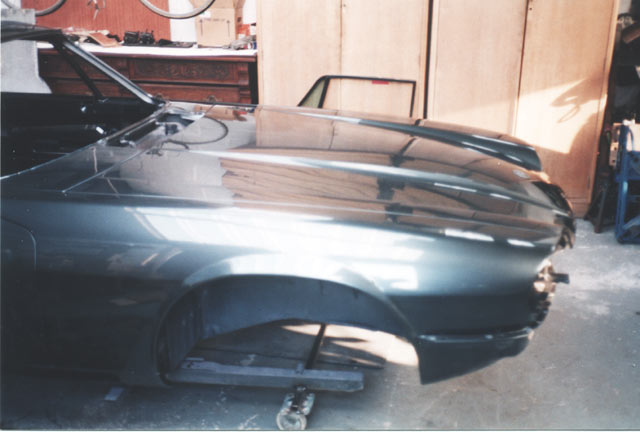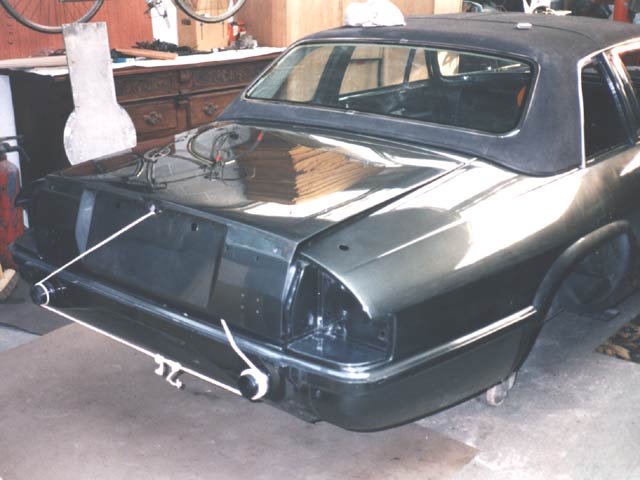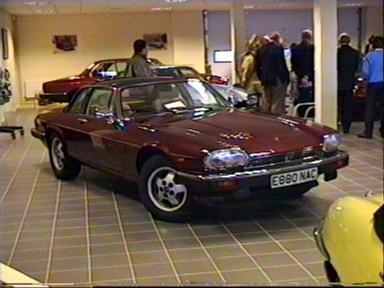

Feline
Reincarnation
Back in 1990, when I was running a Rover 820, it often occurred to me that
this was not the sort of vehicle that I wanted to keep for a long time and began
wondering what I might replace it with. Then
one day I saw a silver XJS parked in a road near to our house, it was an oldish
model but appeared to be well cared for and had not aged in the way that many
other cars of a similar vintage had, not only in terms of obvious external
condition, but also in style. Naturally,I had seen a great number of these cars
in the past but had never really given them much more than a casual glance, thinking as many people do, that ordinary folk like me don't run Jaguars.
From then on I started to mull over the situation in my mind. Having an
Engineering background and always having serviced my own vehicles (both cars and
motorcycles) there would be no huge bills for labour charges, just the parts
would be expensive. The depreciation on the age of vehicle I could afford would
be quite low, and as my Wife and I frequently tour the Continent for our
annual holidays by Motorcycle, the car fuel costs for the year would be
reasonable. Slowly I began to
realise that I could not afford NOT to have an XJS, so I started to collect as
much information as possible about the marque and settled down to find a
suitable vehicle.
At this point I must say that I had no intention of buying one "off
the peg" from a franchised dealer (I am not in that league) but would
instead, look for a suitably damaged specimen, with the right history, which is
the way most of our vehicles have been obtained for many years now.
The first thing which
required a decision was whether to look for something which would require a new
bodyshell or one which would need major surgery, possibly including jigging.
This was solved by my finding a very lightly damaged almost new Coupe shell
which was quickly bought and repaired but not repainted as I still had to find a
suitable donor vehicle.
The next few months were spent inspecting a large number of damaged cars,
both V12's and 3.6's until I eventually landed a 1986 3.6 Coupe (manual) with
25000 miles recorded and all service records and documents to verify. It even
had a tool kit, spare wheel and the original Clarion radio. The damage, although
severe, was confined to the drivers side and dictated that a full reshell was
required which was reflected in the asking price. The interior, dash and front
end mechanicals were in excellent condition and the only major suspension damage
was confined to the rear subframe and offside lower link, which are the same as
the saloons, so parts were plentiful.
I was now in a position to start on my "Big Boys Meccano Set", but before work commenced, fate took a hand in the shape of an advert for an unused Cabriolet bodyshell from a chap who had had similar ideas to me but had lost interest.
|
|
Needless to say, after checking to see what differences there were and how many extra parts would be needed, the money changed hands and I then had a very good Coupe shell to dispose of. For the first time in my motoring life I actually found it as easy to sell unwanted parts as it was to buy them and met a great number of useful contacts in the process. On this note I feel that I must mention Classic Components of Darlington as a source of good quality parts at sensible prices and the willingness and helpful manner in the way which the proprieters, Peter Robertshaw and David Cox, do business is most encouraging these days.
Work now started in earnest on the project and it was not as daunting as
may at first be thought. I had
already bought the set of genuine workshop manuals and the official parts book
and had spent many a happy hour poring over them. The most important thing was
to devise a workplan, take as many detailed photographs as possible and make
notes where necessary to ensure that I knew the routes of cables, harnesses,
pipes and the positions of brackets and clips.
In addition, not to
dismantle anything until I had got the photos back from processing!
The next stage was to spend
almost a month pumping every cavity in the new shell with Waxoyl and treating
the whole of the underbody with underseal from the same source, not a pleasant
task, but well worth the effort, because it then meant that the interesting part
could begin. For any of you who have done work of this nature before, I need not
dwell on the fact that the last parts to come off the old shell (usually the
wiring harnesses and clips), are the first to go back on the new one, this
dictates that you must have a fair amount of space to store virtually 2 cars and
a lot of parts!
The interior was removed and stored away, followed by the major
mechanical components and finally, the myriad clips, pipes, brackets, sound
deadening panels and eventually,
the main wiring harnesses. These were then transferred to the newly painted
shell and in the words of a famous make of manual, reassembly was in the
"reverse order of removal!!!" The
rear suspension was rebuilt using a second-hand subframe and lower link, which
were given the usual treatment of blasting and painting, new handbrake pads were
fitted and I soon had a rolling shell which only required trimming and glazing.
There were very few parts which required modification, except the two rear
quarter trim panels which were quite straightforward as the Coupe has a narrower
'B' post, so a little of the backing was removed and the material glued back. I
fitted the original rear seat from the Coupe, instead of buying the stowage
lockers, which would probably be difficult to find now.
Other parts which had to be found were the fuel tank and breather system
(the Cabriolet tank is different from the Coupe) rear quarter glasses and seals,
the rear parcel shelf and a few interior trim panels. An underbody brace was made, as per the factory one, to make
up for the strength lost in the Cabriolet shell by the absence of a roof skin
and rear buttresses (although this is negligible compared with a full
Convertible). A few other changes included:-
Starfish wheels (as fitted to 3.6 Cabriolets), optional rear hardtop with
glass heated rear window and fog lamps. The only job which I entrusted to an 'expert' was the re-pressurising of the Air Conditioning and that was done by a
local Refrigeration Engineer.
|
|
Here are a couple of shots of my Cabriolet, which I built from a new shell and a damaged donor.
Whilst on holiday in Scotland I spotted an old Escort van at the place we
were staying, which provided a nice finishing touch, in the form of an XJS
registration number. The car has
now done another 10,000 trouble free miles and is a delight to own and drive. We
joined the Club midway through last year and have been to a couple of events
with the car and this has spurred me on to start again but this time with an
older vehicle (a very sorry looking 1968 240 with no history at all, but I'm
hoping for some help there).
I suppose some people may be asking if it was all worth the effort involved, well I can only say that I would never have been able to afford such a low mileage car with a totally rust free body. It is also one which I feel that I can really be proud to own and know exactly its overall condition and have no fears of having to maintain it myself in the future.

One of the very last Cabriolets built, before Jaguar moved on to a full convertible.
Somewhere I have a picture of the actual Cabriolet which Princess Diana once owned. It is now also housed in the Jaguar Daimler Heritage Trust Museum. You may remember that when the Boys grew a bit, she changed it, controversially, for a Mercedes!